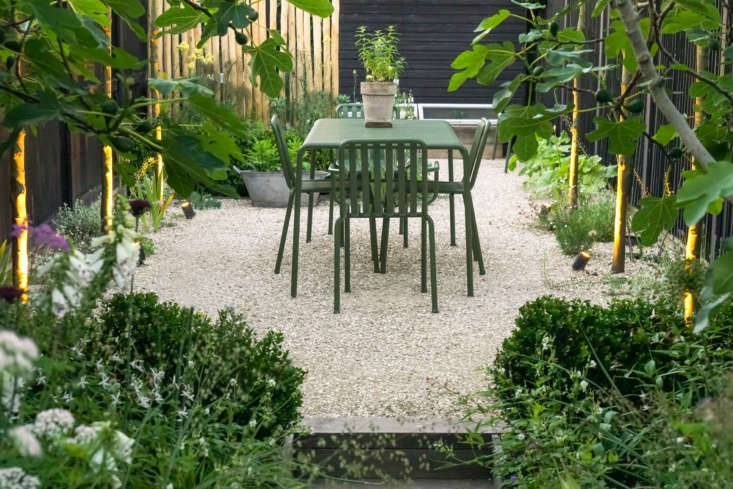A garden in crisis greeted designers Harriet Farlam and Ben Chandler of Farlam & Chandler in 2016. Dingy concrete paving slabs and a completely overgrown garden set a sad tone in the long, narrow space in the heart of the English harbor town of Whitstable, Kent.
“Unnecessary low brick walls enclosed borders planted with two tall bay trees, which were still in their plastic pots, their roots bursting out,” Farlam says. “The bay trees were growing up through two mature fig trees, and everything was smothered in Virginia creeper.”
The plan: “We lived with the garden as it was for a year, through all of the seasons, without touching it too much at all, apart from the immediate removal of the cherry tree,” she says. “This enabled us to really understand the light and how we would use and utilize the small space.”
The result: The courtyard was sited about a quarter mile away from the sea and was relatively protected from sea salt and wind. “Once we had an understanding of how the garden should function, we were able to create a plan for the garden, with the actual layout and bones of the garden very simplistic,” she says.
Photography courtesy of Farlam & Chandler.

A sunken boardwalk made of English oak leads out from the breakfast terrace, journeying through “intense planted long borders” beneath the fig trees. “The path was inspired by a public footpath along the beach in Whitstable. Instead of traditionally floating a boardwalk above planting, we decided to sink our oak path, to create interest in the garden by changing levels but also to provide an increased sense of privacy. We made the path fairly narrow (just wide enough for a wheelbarrow), to encourage you to stop and pause to look and interact with the plants on route to the dining terrace,” Farlam says.

“The true character of the garden is formed with the layering of plants, which were selected to define the individual character of each area, but still be harmonious when journeying through the garden, the ‘journey’ being a very important aspect of the space,” Farlam says.

Although the courtyard is buffered from sea salt and wind, a lot of the plants Farlam and Chandler chose (including lavender, rosemary, thyme, alliums, geraniums, angelica, iris, asters, fennel, and Erigeron) are salt tolerant. The fig trees provided the inspiration to use a lot of edible and medicinal plants, such as crabapple trees, valerian, angelica, and herbs.

Before

“The boundaries were completely overgrown with variegated ivy, making the garden feel very narrow and oppressive,” she says.

After

Visible on either side of the dining terrace are the trunks of pleached crabapple trees, planted in the crushed shell surface. (The surface is a bespoke mix of crushed cockle shells with limestone chips and dust.) The crabapple trees provide both privacy and vertical interest.
“It was astonishing how many birds we had in the garden, we also didn’t want our new design to impact or discourage any wildlife. The existing fig trees were integral to this concept and we carefully cleared the shrubbery and trees around them to reveal them and allow them to act as focal points in the space,” Farlam says. “We stripped the boundaries of the ivy and painted the fences black, inspired by the fisherman huts on the beach, which immediately made the garden feel much bigger and the colors of the new planting pop against the dark backdrop.”

“The intensity of planting disperses as you pass beneath the two sculptural fig trees into a calm, refined palette of plants in the dining terrace, a simple rectangular space with centrally positioned table and chairs,” says Farlam.


The border in front of this screening is planted with less restraint than closer to the house, says Farlam: Thalictrum, purple fennel, eryngium, crambe, and poppies create “a riot of color and texture, loosely reflecting the plant palette found on the beach.”
N.B.: This post is an update; it was first published July 2018.
If you’re looking for more inspiration to design a small or narrow garden, start with our curated guides to Garden Design 101 for suggestions for Decks & Patios, Pavers, and Perennials and Annuals. See more of our favorite Before & After projects:
- Before & After: A Vintage Florida Cottage and Garden Saved from the Landfill—on a $12,500 Budget
- Before & After: An Airy Gravel Garden for a Midcentury British House in West Dorset
- Before & After: From Desert to Redwood Forest, the Essence of California in One LA Garden








Have a Question or Comment About This Post?
Join the conversation